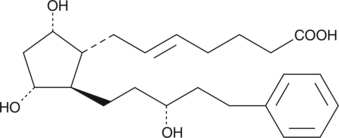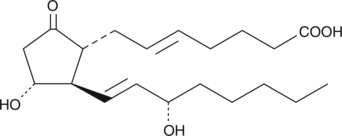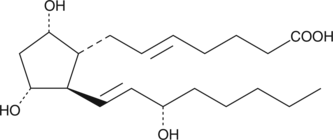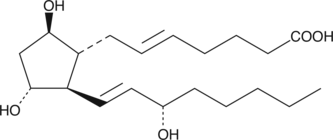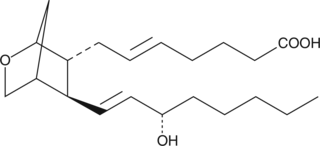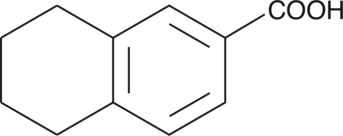Chemicals
Showing 6601–6750 of 41137 results
-
In addition to its role in the Krebs cycle, α-ketoglutarate (2-oxoglutarate) has roles as a substrate or modulator of enzymes. 5-Octyl-α-ketoglutarate, also known as α-ketoglutarate octyl ester, is a stable, cell-permeable molecule that generates free α-ketoglutarate upon hydrolysis of the ester bond by cytoplasmic esterases.{21289} It is used in experiments to increase levels of intracellular α-ketoglutarate.{21289} 5-Octyl-α-ketoglutarate has been shown to modulate a variety of enzymes and signaling pathways, particularly in the context of glycolysis, hypoxia, and cancer.{21289,26774,27744,27745,26069}
Brand:CaymanSKU:-5-OxoETE is a polyunsaturated keto acid formed by the oxidation of 5-HETE in human neutrophils by a specific dehydrogenase.{2090} It stimulates cytosolic calcium levels in neutrophils with an EC50 value of 2 nM.{1434} 5-OxoETE selectively stimulates the migration and degranulation of eosinophils and activates the MAPK pathway in stimulated neutrophils via a specific G protein-coupled receptor.{2793,3036,10476,11003}
Brand:CaymanSKU:34250 - 100 µgAvailable on backorder
5-OxoETE is a polyunsaturated keto acid formed by the oxidation of 5-HETE in human neutrophils by a specific dehydrogenase.{2090} It stimulates cytosolic calcium levels in neutrophils with an EC50 value of 2 nM.{1434} 5-OxoETE selectively stimulates the migration and degranulation of eosinophils and activates the MAPK pathway in stimulated neutrophils via a specific G protein-coupled receptor.{2793,3036,10476,11003}
Brand:CaymanSKU:34250 - 25 µgAvailable on backorder
5-OxoETE is a polyunsaturated keto acid formed by the oxidation of 5-HETE in human neutrophils by a specific dehydrogenase.{2090} It stimulates cytosolic calcium levels in neutrophils with an EC50 value of 2 nM.{1434} 5-OxoETE selectively stimulates the migration and degranulation of eosinophils and activates the MAPK pathway in stimulated neutrophils via a specific G protein-coupled receptor.{2793,3036,10476,11003}
Brand:CaymanSKU:34250 - 250 µgAvailable on backorder
5-OxoETE is a polyunsaturated keto acid formed by the oxidation of 5-HETE in human neutrophils by a specific dehydrogenase.{2090} It stimulates cytosolic calcium levels in neutrophils with an EC50 value of 2 nM.{1434} 5-OxoETE selectively stimulates the migration and degranulation of eosinophils and activates the MAPK pathway in stimulated neutrophils via a specific G protein-coupled receptor.{2793,3036,10476,11003}
Brand:CaymanSKU:34250 - 50 µgAvailable on backorder
5-OxoETE is a polyunsaturated keto acid formed by the oxidation of 5-HETE in human neutrophils by a specific dehydrogenase.{2090} It stimulates cytosolic calcium levels in neutrophils with an EC50 value of 2 nM.{1434} 5-OxoETE selectively stimulates the migration and degranulation of eosinophils and activates the MAPK pathway in stimulated neutrophils via a specific G protein-coupled receptor.{2793,3036,10476,11003} 5-OxoETE MaxSpec® standard is a quantitative grade standard of 5-oxoETE (Item No. 34250) that has been prepared specifically for mass spectrometry and related applications where quantitative reproducibility is required. The solution has been prepared gravimetrically and is supplied in a deactivated glass ampule sealed under argon. The concentration was verified by comparison to an independently prepared calibration standard. This 5-oxoETE MaxSpec® standard is guaranteed to meet identity, purity, stability, and concentration specifications and is provided with a batch-specific certificate of analysis. Ongoing stability testing is performed to ensure the concentration remains accurate throughout the shelf life of the product. Note: The amount of solution added to the vial is in excess of the listed amount. Therefore, it is necessary to accurately measure volumes for preparation of calibration standards. Follow recommended storage and handling conditions to maintain product quality.
Brand:CaymanSKU:10007244 - 10 µgAvailable on backorder
5-OxoETE methyl ester is an esterified form of the polyunsaturated keto acid 5-oxoETE (Item No. 34250). 5-OxoETE methyl ester is an agonist of oxoeicosanoid receptor 1 (OXER1; EC50 = 1.54 µM for β-arrestin recruitment) that has a higher maximal response than 5-oxoETE in a β-arrestin assay.{45089}
Brand:CaymanSKU:26059 - 100 µgAvailable on backorder
5-OxoETE methyl ester is an esterified form of the polyunsaturated keto acid 5-oxoETE (Item No. 34250). 5-OxoETE methyl ester is an agonist of oxoeicosanoid receptor 1 (OXER1; EC50 = 1.54 µM for β-arrestin recruitment) that has a higher maximal response than 5-oxoETE in a β-arrestin assay.{45089}
Brand:CaymanSKU:26059 - 25 µgAvailable on backorder
5-OxoETE methyl ester is an esterified form of the polyunsaturated keto acid 5-oxoETE (Item No. 34250). 5-OxoETE methyl ester is an agonist of oxoeicosanoid receptor 1 (OXER1; EC50 = 1.54 µM for β-arrestin recruitment) that has a higher maximal response than 5-oxoETE in a β-arrestin assay.{45089}
Brand:CaymanSKU:26059 - 250 µgAvailable on backorder
5-OxoETE methyl ester is an esterified form of the polyunsaturated keto acid 5-oxoETE (Item No. 34250). 5-OxoETE methyl ester is an agonist of oxoeicosanoid receptor 1 (OXER1; EC50 = 1.54 µM for β-arrestin recruitment) that has a higher maximal response than 5-oxoETE in a β-arrestin assay.{45089}
Brand:CaymanSKU:26059 - 50 µgAvailable on backorder
Branched fatty acid esters of hydroxy fatty acids (FAHFAs) are newly identified endogenous lipids regulated by fasting and high-fat feeding and associated with insulin sensitivity.{27644} 5-PAHSA is a FAHFA in which palmitic acid is esterified at the 5th carbon of hydroxy stearic acid. PAHSA isoforms are the most abundant forms of FAHFA identified in the adipose tissue of glucose tolerant AG4OX mice.{27644} PAHSAs are synthesized in vivo in both mice and humans and are regulated by fasting and high-fat feeding in mice.{27644} PAHSA levels correlate highly with insulin sensitivity and are reduced in adipose tissue and serum of insulin-resistant humans. PAHSA administration lowers ambient glycemia, improves glucose tolerance, and stimulates GLP-1 and insulin secretion in mice.{27644}
Brand:CaymanSKU:-Out of stock
Branched fatty acid esters of hydroxy fatty acids (FAHFAs) are newly identified endogenous lipids regulated by fasting and high-fat feeding and associated with insulin sensitivity.{27644} 5-PAHSA is a FAHFA in which palmitic acid is esterified at the 5th carbon of hydroxy stearic acid. PAHSA isoforms are the most abundant forms of FAHFA identified in the adipose tissue of glucose tolerant AG4OX mice.{27644} PAHSAs are synthesized in vivo in both mice and humans and are regulated by fasting and high-fat feeding in mice.{27644} PAHSA levels correlate highly with insulin sensitivity and are reduced in adipose tissue and serum of insulin-resistant humans. PAHSA administration lowers ambient glycemia, improves glucose tolerance, and stimulates GLP-1 and insulin secretion in mice.{27644}
Brand:CaymanSKU:-Out of stock
Branched fatty acid esters of hydroxy fatty acids (FAHFAs) are newly identified endogenous lipids regulated by fasting and high-fat feeding and associated with insulin sensitivity.{27644} 5-PAHSA is a FAHFA in which palmitic acid is esterified at the 5th carbon of hydroxy stearic acid. PAHSA isoforms are the most abundant forms of FAHFA identified in the adipose tissue of glucose tolerant AG4OX mice.{27644} PAHSAs are synthesized in vivo in both mice and humans and are regulated by fasting and high-fat feeding in mice.{27644} PAHSA levels correlate highly with insulin sensitivity and are reduced in adipose tissue and serum of insulin-resistant humans. PAHSA administration lowers ambient glycemia, improves glucose tolerance, and stimulates GLP-1 and insulin secretion in mice.{27644}
Brand:CaymanSKU:-Out of stock
5-Phenyllevulinic acid is a fungal metabolite that has been found in Cytospora.{55016} It is active against the bacterium B. megaterium, plant pathogenic fungus S. tritici, and alga C. fusca. 5-Phenyllevulinic acid is also an intermediate in the synthesis of sigma (σ) receptor ligands.{55017}
Brand:CaymanSKU:28401 - 1 mgAvailable on backorder
Travoprost is the Alcon trade name for fluprostenol isopropyl ester, an F-series prostaglandin analog which has been approved for use as an ocular hypotensive drug.{9613} Fluprostenol isopropyl ester is a prodrug which is converted by esterase enzymatic activity in the cornea to yield the corresponding free acid, fluprostenol.{8839} 5-trans Fluprostenol is an impurity that is routinely found in bulk preparations of fluprostenol in amounts ranging from 1-3%. This impurity occurs in the finished prodrug Travoprost in similar amounts. The pharmacology of 5-trans fluprostenol has not been studied extensively to date.
Brand:CaymanSKU:-Out of stock
Travoprost is the Alcon trade name for fluprostenol isopropyl ester, an F-series prostaglandin analog which has been approved for use as an ocular hypotensive drug.{9613} Fluprostenol isopropyl ester is a prodrug which is converted by esterase enzymatic activity in the cornea to yield the corresponding free acid, fluprostenol.{8839} 5-trans Fluprostenol is an impurity that is routinely found in bulk preparations of fluprostenol in amounts ranging from 1-3%. This impurity occurs in the finished prodrug Travoprost in similar amounts. The pharmacology of 5-trans fluprostenol has not been studied extensively to date.
Brand:CaymanSKU:-Out of stock
Travoprost is the Alcon trade name for fluprostenol isopropyl ester, an F-series prostaglandin analog which has been approved for use as an ocular hypotensive drug.{9613} Fluprostenol isopropyl ester is a prodrug which is converted by esterase enzymatic activity in the cornea to yield the corresponding free acid, fluprostenol.{8839} 5-trans Fluprostenol is an impurity that is routinely found in bulk preparations of fluprostenol in amounts ranging from 1-3%. This impurity occurs in the finished prodrug Travoprost in similar amounts. The pharmacology of 5-trans fluprostenol has not been studied extensively to date.
Brand:CaymanSKU:-Out of stock
Travoprost is the Alcon trade name for fluprostenol isopropyl ester, an F-series prostaglandin analog which has been approved for use as an ocular hypotensive drug.{8839,9613} Fluprostenol isopropyl ester is a prodrug which is converted by esterase enzymatic activity in the cornea to yield the corresponding free acid.{8839} 5-trans Fluprostenol isopropyl ester (5-trans Travoprost) is an impurity that is routinely found in bulk preparations of fluprostenol isopropyl ester in amounts ranging from 1-3%. The pharmacology of 5-trans fluprostenol isopropyl ester has not been studied extensively to date.
Brand:CaymanSKU:-Out of stock
Travoprost is the Alcon trade name for fluprostenol isopropyl ester, an F-series prostaglandin analog which has been approved for use as an ocular hypotensive drug.{8839,9613} Fluprostenol isopropyl ester is a prodrug which is converted by esterase enzymatic activity in the cornea to yield the corresponding free acid.{8839} 5-trans Fluprostenol isopropyl ester (5-trans Travoprost) is an impurity that is routinely found in bulk preparations of fluprostenol isopropyl ester in amounts ranging from 1-3%. The pharmacology of 5-trans fluprostenol isopropyl ester has not been studied extensively to date.
Brand:CaymanSKU:-Out of stock
Travoprost is the Alcon trade name for fluprostenol isopropyl ester, an F-series prostaglandin analog which has been approved for use as an ocular hypotensive drug.{8839,9613} Fluprostenol isopropyl ester is a prodrug which is converted by esterase enzymatic activity in the cornea to yield the corresponding free acid.{8839} 5-trans Fluprostenol isopropyl ester (5-trans Travoprost) is an impurity that is routinely found in bulk preparations of fluprostenol isopropyl ester in amounts ranging from 1-3%. The pharmacology of 5-trans fluprostenol isopropyl ester has not been studied extensively to date.
Brand:CaymanSKU:-Out of stock
Travoprost is the Alcon trade name for fluprostenol isopropyl ester, an F-series prostaglandin analog which has been approved for use as an ocular hypotensive drug.{8839,9613} Fluprostenol isopropyl ester is a prodrug which is converted by esterase enzymatic activity in the cornea to yield the corresponding free acid.{8839} 5-trans Fluprostenol isopropyl ester (5-trans Travoprost) is an impurity that is routinely found in bulk preparations of fluprostenol isopropyl ester in amounts ranging from 1-3%. The pharmacology of 5-trans fluprostenol isopropyl ester has not been studied extensively to date.
Brand:CaymanSKU:-Out of stock
Latanoprost is an F-series prostaglandin analog which has been approved for use as an ocular hypotensive drug.{1107} 5-trans Latanoprost is an isomer of latanoprost wherein the double bond between carbons 5 and 6 has been changed from cis (Z) to trans (E). The trans isomer of latanoprost occurs as an impurity of between 2-5% in most commercial preparations of the bulk drug product. The present compound was prepared primarily as an analytical standard for detection and quantitation of this impurity. From what can be inferred from the study of other trans isomers of F-type prostaglandins, 5-trans latanoprost’s biological activity is likely to be similar to that of the cis isomer. However, there are no specific published reports on the biological activity, and on the intraocular hypotensive activity in particular, of 5-trans latanoprost.
Brand:CaymanSKU:-Out of stock
Latanoprost is an F-series prostaglandin analog which has been approved for use as an ocular hypotensive drug.{1107} 5-trans Latanoprost is an isomer of latanoprost wherein the double bond between carbons 5 and 6 has been changed from cis (Z) to trans (E). The trans isomer of latanoprost occurs as an impurity of between 2-5% in most commercial preparations of the bulk drug product. The present compound was prepared primarily as an analytical standard for detection and quantitation of this impurity. From what can be inferred from the study of other trans isomers of F-type prostaglandins, 5-trans latanoprost’s biological activity is likely to be similar to that of the cis isomer. However, there are no specific published reports on the biological activity, and on the intraocular hypotensive activity in particular, of 5-trans latanoprost.
Brand:CaymanSKU:-Out of stock
Latanoprost is an F-series prostaglandin analog which has been approved for use as an ocular hypotensive drug.{1107} 5-trans Latanoprost is an isomer of latanoprost wherein the double bond between carbons 5 and 6 has been changed from cis (Z) to trans (E). The trans isomer of latanoprost occurs as an impurity of between 2-5% in most commercial preparations of the bulk drug product. The present compound was prepared primarily as an analytical standard for detection and quantitation of this impurity. From what can be inferred from the study of other trans isomers of F-type prostaglandins, 5-trans latanoprost’s biological activity is likely to be similar to that of the cis isomer. However, there are no specific published reports on the biological activity, and on the intraocular hypotensive activity in particular, of 5-trans latanoprost.
Brand:CaymanSKU:-Out of stock
Latanoprost is an F-series prostaglandin analog which has been approved for use as an ocular hypotensive drug.{1107} 5-trans Latanoprost is an isomer of latanoprost wherein the double bond between carbons 5 and 6 has been changed from cis (Z) to trans (E). The trans isomer of latanoprost occurs as an impurity of between 2-5% in most commercial preparations of the bulk drug product. The present compound was prepared primarily as an analytical standard for detection and quantitation of this impurity. From what can be inferred from the study of other trans isomers of F-type prostaglandins, 5-trans latanoprost’s biological activity is likely to be similar to that of the cis isomer. However, there are no specific published reports on the biological activity, and on the intraocular hypotensive activity in particular, of 5-trans latanoprost.
Brand:CaymanSKU:-Out of stock
Latanoprost (Item No. 16812) is an F-series prostaglandin (PG) analog which has been approved for use as an ocular hypotensive drug.{1107} Latanoprost is an isopropyl ester, a prodrug form which is converted to latanoprost (free acid) by endogenous esterase enzymes. The free acid form is 200 times more potent than latanoprost as a ligand for the human recombinant FP receptor.{8322} 5-trans Latanoprost (free acid) is an isomer of latanoprost (free acid) wherein the double bond between carbons 5 and 6 has been changed from cis (Z) to trans (E). The trans isomer of latanoprost occurs as an impurity in commercial preparations of the bulk drug product. The present compound was prepared primarily as an analytical standard for detection and quantitation of this impurity. From what can be inferred from the study of other trans isomers of F-type prostaglandins, the biological activity of this isomer is likely to be similar to that of the cis isomer. However, there are no specific published reports on the biological activity, and on reducing intraocular pressure in particular, of 5-trans latanoprost.
Brand:CaymanSKU:10129 - 1 mgAvailable on backorder
Latanoprost (Item No. 16812) is an F-series prostaglandin (PG) analog which has been approved for use as an ocular hypotensive drug.{1107} Latanoprost is an isopropyl ester, a prodrug form which is converted to latanoprost (free acid) by endogenous esterase enzymes. The free acid form is 200 times more potent than latanoprost as a ligand for the human recombinant FP receptor.{8322} 5-trans Latanoprost (free acid) is an isomer of latanoprost (free acid) wherein the double bond between carbons 5 and 6 has been changed from cis (Z) to trans (E). The trans isomer of latanoprost occurs as an impurity in commercial preparations of the bulk drug product. The present compound was prepared primarily as an analytical standard for detection and quantitation of this impurity. From what can be inferred from the study of other trans isomers of F-type prostaglandins, the biological activity of this isomer is likely to be similar to that of the cis isomer. However, there are no specific published reports on the biological activity, and on reducing intraocular pressure in particular, of 5-trans latanoprost.
Brand:CaymanSKU:10129 - 10 mgAvailable on backorder
Latanoprost (Item No. 16812) is an F-series prostaglandin (PG) analog which has been approved for use as an ocular hypotensive drug.{1107} Latanoprost is an isopropyl ester, a prodrug form which is converted to latanoprost (free acid) by endogenous esterase enzymes. The free acid form is 200 times more potent than latanoprost as a ligand for the human recombinant FP receptor.{8322} 5-trans Latanoprost (free acid) is an isomer of latanoprost (free acid) wherein the double bond between carbons 5 and 6 has been changed from cis (Z) to trans (E). The trans isomer of latanoprost occurs as an impurity in commercial preparations of the bulk drug product. The present compound was prepared primarily as an analytical standard for detection and quantitation of this impurity. From what can be inferred from the study of other trans isomers of F-type prostaglandins, the biological activity of this isomer is likely to be similar to that of the cis isomer. However, there are no specific published reports on the biological activity, and on reducing intraocular pressure in particular, of 5-trans latanoprost.
Brand:CaymanSKU:10129 - 5 mgAvailable on backorder
5-trans PGE2 occurs naturally in some gorgonian corals and is a common impurity in commercial lots of PGE1.{2213} It is 18 times more potent than PGE2 in activating adenylate cyclase in NCB-20 cell homogenates.{2180} 5-trans PGE2 accelerates fibrinolysis by enhancing plasminogen activation mediated by tissue-type plasminogen activator.{2177} It also inhibits platelet aggregation in human PRP with an IC50 of 180 nM.{1607}
Brand:CaymanSKU:-5-trans PGE2 occurs naturally in some gorgonian corals and is a common impurity in commercial lots of PGE1.{2213} It is 18 times more potent than PGE2 in activating adenylate cyclase in NCB-20 cell homogenates.{2180} 5-trans PGE2 accelerates fibrinolysis by enhancing plasminogen activation mediated by tissue-type plasminogen activator.{2177} It also inhibits platelet aggregation in human PRP with an IC50 of 180 nM.{1607}
Brand:CaymanSKU:-5-trans PGE2 occurs naturally in some gorgonian corals and is a common impurity in commercial lots of PGE1.{2213} It is 18 times more potent than PGE2 in activating adenylate cyclase in NCB-20 cell homogenates.{2180} 5-trans PGE2 accelerates fibrinolysis by enhancing plasminogen activation mediated by tissue-type plasminogen activator.{2177} It also inhibits platelet aggregation in human PRP with an IC50 of 180 nM.{1607}
Brand:CaymanSKU:-5-trans PGF2α is the more thermodynamically stable C-5 olefin isomer of PGF2α and is a common impurity in commercial lots of PGF2α. 5-trans PGF2α administered intravenously to anesthetized rabbits caused a substantial (ten-fold) increase in respiratory rate, but this attribute was common to a number of F-series compounds and analogs.{2224}
Brand:CaymanSKU:-5-trans PGF2α is the more thermodynamically stable C-5 olefin isomer of PGF2α and is a common impurity in commercial lots of PGF2α. 5-trans PGF2α administered intravenously to anesthetized rabbits caused a substantial (ten-fold) increase in respiratory rate, but this attribute was common to a number of F-series compounds and analogs.{2224}
Brand:CaymanSKU:-5-trans PGF2α is the more thermodynamically stable C-5 olefin isomer of PGF2α and is a common impurity in commercial lots of PGF2α. 5-trans PGF2α administered intravenously to anesthetized rabbits caused a substantial (ten-fold) increase in respiratory rate, but this attribute was common to a number of F-series compounds and analogs.{2224}
Brand:CaymanSKU:-5-trans PGF2α tromethamine salt is a derivative of 5-trans PGF2α with increased water solubility. Its solubility in PBS is 25 mg/ml compared to 10 mg/ml for 5-trans PGF2α.
Brand:CaymanSKU:-5-trans PGF2α tromethamine salt is a derivative of 5-trans PGF2α with increased water solubility. Its solubility in PBS is 25 mg/ml compared to 10 mg/ml for 5-trans PGF2α.
Brand:CaymanSKU:-5-trans PGF2α tromethamine salt is a derivative of 5-trans PGF2α with increased water solubility. Its solubility in PBS is 25 mg/ml compared to 10 mg/ml for 5-trans PGF2α.
Brand:CaymanSKU:-5-trans PGF2β is the 9β-hydroxy isomer of 5-trans PGF2α. There are no published reports on the biological activity of this compound.
Brand:CaymanSKU:-5-trans PGF2β is the 9β-hydroxy isomer of 5-trans PGF2α. There are no published reports on the biological activity of this compound.
Brand:CaymanSKU:-5-trans PGF2β is the 9β-hydroxy isomer of 5-trans PGF2α. There are no published reports on the biological activity of this compound.
Brand:CaymanSKU:-5-trans U-44069 is the trans isomer of the thromboxane receptor agonist U-44069 (Item No. 16440). It inhibits microsomal prostaglandin E2 synthase (mPGES) when used at a concentration of 10 µM.{10397}
Brand:CaymanSKU:-Out of stock
5-trans U-44069 is the trans isomer of the thromboxane receptor agonist U-44069 (Item No. 16440). It inhibits microsomal prostaglandin E2 synthase (mPGES) when used at a concentration of 10 µM.{10397}
Brand:CaymanSKU:-Out of stock
5-trans U-44069 is the trans isomer of the thromboxane receptor agonist U-44069 (Item No. 16440). It inhibits microsomal prostaglandin E2 synthase (mPGES) when used at a concentration of 10 µM.{10397}
Brand:CaymanSKU:-Out of stock
5-trans U-44619 is the trans isomer of the thromboxane receptor agonist U-44619 (Item No. 16450). It inhibits microsomal prostaglandin E2 synthase (mPGES) when used at a concentration of 10 µM.{10397}
Brand:CaymanSKU:-Out of stock
5-trans U-44619 is the trans isomer of the thromboxane receptor agonist U-44619 (Item No. 16450). It inhibits microsomal prostaglandin E2 synthase (mPGES) when used at a concentration of 10 µM.{10397}
Brand:CaymanSKU:-Out of stock
5-trans U-44619 is the trans isomer of the thromboxane receptor agonist U-44619 (Item No. 16450). It inhibits microsomal prostaglandin E2 synthase (mPGES) when used at a concentration of 10 µM.{10397}
Brand:CaymanSKU:-Out of stock
17-phenyl trinor Prostaglandin F2α ethyl amide (17-phenyl trinor PGF2α ethyl amide) is an F-series PG analog which has been approved for use as an ocular hypotensive drug.{8941} 5-trans-17-phenyl trinor PGF2α ethyl amide is an isomer of 17-phenyl trinor PGF2α ethyl amide wherein the double bond between carbons 5 and 6 has been changed from cis (Z) to trans (E). The trans isomer of 17-phenyl trinor PGF2α ethyl amide occurs as an impurity in commercial preparations of the bulk drug product. The present compound was prepared primarily as an analytical standard for detection and quantitation of this impurity. From what can be inferred from the study of other trans isomers of F-type PGs, the biological activity of this isomer is likely to be similar to that of the cis isomer. However, there are no specific published reports on the biological activity of 5-trans-17-phenyl trinor PGF2α ethyl amide.
Brand:CaymanSKU:10008132 - 1 mgAvailable on backorder
17-phenyl trinor Prostaglandin F2α ethyl amide (17-phenyl trinor PGF2α ethyl amide) is an F-series PG analog which has been approved for use as an ocular hypotensive drug.{8941} 5-trans-17-phenyl trinor PGF2α ethyl amide is an isomer of 17-phenyl trinor PGF2α ethyl amide wherein the double bond between carbons 5 and 6 has been changed from cis (Z) to trans (E). The trans isomer of 17-phenyl trinor PGF2α ethyl amide occurs as an impurity in commercial preparations of the bulk drug product. The present compound was prepared primarily as an analytical standard for detection and quantitation of this impurity. From what can be inferred from the study of other trans isomers of F-type PGs, the biological activity of this isomer is likely to be similar to that of the cis isomer. However, there are no specific published reports on the biological activity of 5-trans-17-phenyl trinor PGF2α ethyl amide.
Brand:CaymanSKU:10008132 - 10 mgAvailable on backorder
17-phenyl trinor Prostaglandin F2α ethyl amide (17-phenyl trinor PGF2α ethyl amide) is an F-series PG analog which has been approved for use as an ocular hypotensive drug.{8941} 5-trans-17-phenyl trinor PGF2α ethyl amide is an isomer of 17-phenyl trinor PGF2α ethyl amide wherein the double bond between carbons 5 and 6 has been changed from cis (Z) to trans (E). The trans isomer of 17-phenyl trinor PGF2α ethyl amide occurs as an impurity in commercial preparations of the bulk drug product. The present compound was prepared primarily as an analytical standard for detection and quantitation of this impurity. From what can be inferred from the study of other trans isomers of F-type PGs, the biological activity of this isomer is likely to be similar to that of the cis isomer. However, there are no specific published reports on the biological activity of 5-trans-17-phenyl trinor PGF2α ethyl amide.
Brand:CaymanSKU:10008132 - 25 mgAvailable on backorder
17-phenyl trinor Prostaglandin F2α ethyl amide (17-phenyl trinor PGF2α ethyl amide) is an F-series PG analog which has been approved for use as an ocular hypotensive drug.{8941} 5-trans-17-phenyl trinor PGF2α ethyl amide is an isomer of 17-phenyl trinor PGF2α ethyl amide wherein the double bond between carbons 5 and 6 has been changed from cis (Z) to trans (E). The trans isomer of 17-phenyl trinor PGF2α ethyl amide occurs as an impurity in commercial preparations of the bulk drug product. The present compound was prepared primarily as an analytical standard for detection and quantitation of this impurity. From what can be inferred from the study of other trans isomers of F-type PGs, the biological activity of this isomer is likely to be similar to that of the cis isomer. However, there are no specific published reports on the biological activity of 5-trans-17-phenyl trinor PGF2α ethyl amide.
Brand:CaymanSKU:10008132 - 5 mgAvailable on backorder
5-Tricosylresorcinol is an alkylresorcinol that has been found in wheat, rye, triticale, and barley.{46617} It reduces hydrogen peroxide-induced DNA damage in HT-29 cells when used at a concentration of 100 µM.{46618}
Brand:CaymanSKU:30032 - 1 mgAvailable on backorder
5-Tricosylresorcinol is an alkylresorcinol that has been found in wheat, rye, triticale, and barley.{46617} It reduces hydrogen peroxide-induced DNA damage in HT-29 cells when used at a concentration of 100 µM.{46618}
Brand:CaymanSKU:30032 - 10 mgAvailable on backorder
5-Tricosylresorcinol is an alkylresorcinol that has been found in wheat, rye, triticale, and barley.{46617} It reduces hydrogen peroxide-induced DNA damage in HT-29 cells when used at a concentration of 100 µM.{46618}
Brand:CaymanSKU:30032 - 5 mgAvailable on backorder
5-Tricosylresorcinol is an alkylresorcinol that has been found in wheat, rye, triticale, and barley.{46617} It reduces hydrogen peroxide-induced DNA damage in HT-29 cells when used at a concentration of 100 µM.{46618}
Brand:CaymanSKU:30032 - 500 µgAvailable on backorder
Signal transducer and activator of transcription 3 (STAT3) is a cytokine-inducible transcription factor with roles in inflammation and cancer.{7286,11981} 5,15-DPP is a cell-permeable porphyrin derivative that selectively binds STAT3 (Kd = 880 nM).{26153} This inhibits STAT3 dimerization via Src homology 2 (Sh2) domains (IC50 = 280 nM), preventing nuclear translocation and DNA binding.{26153} 5,15-DPP poorly inhibits STAT1 (IC50 = 10 µM) and does not affect Grb2.{26153} It reduces IL-6-dependent STAT3 activation and consequent c-myc expression in MDA-MB-468 cells and blocks TRAIL-induced migration and invasion in A549 cells.{26153,26154} Furthermore, inhibition of JAK/STAT signaling in satellite cells via 5,15-DPP and the JAK2 inhibitor AG-490 (Item No. 10010311) has been used to stimulate muscle regeneration in a model of aging skeletal muscle deterioration.{27730}
Brand:CaymanSKU:-Signal transducer and activator of transcription 3 (STAT3) is a cytokine-inducible transcription factor with roles in inflammation and cancer.{7286,11981} 5,15-DPP is a cell-permeable porphyrin derivative that selectively binds STAT3 (Kd = 880 nM).{26153} This inhibits STAT3 dimerization via Src homology 2 (Sh2) domains (IC50 = 280 nM), preventing nuclear translocation and DNA binding.{26153} 5,15-DPP poorly inhibits STAT1 (IC50 = 10 µM) and does not affect Grb2.{26153} It reduces IL-6-dependent STAT3 activation and consequent c-myc expression in MDA-MB-468 cells and blocks TRAIL-induced migration and invasion in A549 cells.{26153,26154} Furthermore, inhibition of JAK/STAT signaling in satellite cells via 5,15-DPP and the JAK2 inhibitor AG-490 (Item No. 10010311) has been used to stimulate muscle regeneration in a model of aging skeletal muscle deterioration.{27730}
Brand:CaymanSKU:-Signal transducer and activator of transcription 3 (STAT3) is a cytokine-inducible transcription factor with roles in inflammation and cancer.{7286,11981} 5,15-DPP is a cell-permeable porphyrin derivative that selectively binds STAT3 (Kd = 880 nM).{26153} This inhibits STAT3 dimerization via Src homology 2 (Sh2) domains (IC50 = 280 nM), preventing nuclear translocation and DNA binding.{26153} 5,15-DPP poorly inhibits STAT1 (IC50 = 10 µM) and does not affect Grb2.{26153} It reduces IL-6-dependent STAT3 activation and consequent c-myc expression in MDA-MB-468 cells and blocks TRAIL-induced migration and invasion in A549 cells.{26153,26154} Furthermore, inhibition of JAK/STAT signaling in satellite cells via 5,15-DPP and the JAK2 inhibitor AG-490 (Item No. 10010311) has been used to stimulate muscle regeneration in a model of aging skeletal muscle deterioration.{27730}
Brand:CaymanSKU:-Signal transducer and activator of transcription 3 (STAT3) is a cytokine-inducible transcription factor with roles in inflammation and cancer.{7286,11981} 5,15-DPP is a cell-permeable porphyrin derivative that selectively binds STAT3 (Kd = 880 nM).{26153} This inhibits STAT3 dimerization via Src homology 2 (Sh2) domains (IC50 = 280 nM), preventing nuclear translocation and DNA binding.{26153} 5,15-DPP poorly inhibits STAT1 (IC50 = 10 µM) and does not affect Grb2.{26153} It reduces IL-6-dependent STAT3 activation and consequent c-myc expression in MDA-MB-468 cells and blocks TRAIL-induced migration and invasion in A549 cells.{26153,26154} Furthermore, inhibition of JAK/STAT signaling in satellite cells via 5,15-DPP and the JAK2 inhibitor AG-490 (Item No. 10010311) has been used to stimulate muscle regeneration in a model of aging skeletal muscle deterioration.{27730}
Brand:CaymanSKU:-5,6-dehydro Arachidonic acid is an analog of arachidonic acid with an acetylene in the 5,6 position. It inhibits 5-LO in rat basophilic leukemia cells, with a Ki value of 15 µM.{4049} In guinea pig leukocytes, 5-LO is inhibited by 5,6-dehydro arachidonic acid with an IC50 value of 10 µM.{472}
Brand:CaymanSKU:90020 - 100 µgAvailable on backorder
5,6-dehydro Arachidonic acid is an analog of arachidonic acid with an acetylene in the 5,6 position. It inhibits 5-LO in rat basophilic leukemia cells, with a Ki value of 15 µM.{4049} In guinea pig leukocytes, 5-LO is inhibited by 5,6-dehydro arachidonic acid with an IC50 value of 10 µM.{472}
Brand:CaymanSKU:90020 - 25 µgAvailable on backorder
5,6-dehydro Arachidonic acid is an analog of arachidonic acid with an acetylene in the 5,6 position. It inhibits 5-LO in rat basophilic leukemia cells, with a Ki value of 15 µM.{4049} In guinea pig leukocytes, 5-LO is inhibited by 5,6-dehydro arachidonic acid with an IC50 value of 10 µM.{472}
Brand:CaymanSKU:90020 - 50 µgAvailable on backorder
5,6-dihydro-5-Fluorouracil (5-FUH2) is formed by the hydrogenation of 5-fluorouracil (5-FU; Item No. 14416) via the enzyme dihydropyrimidine dehydrogenase (DPD).{34392} Formulations containing 5-FU are used for the treatment of cancer. However, in patients lacking full DPD activity, severe adverse events, including death, can occur. 5-FUH2 is less toxic than 5-FU but is not as effective (IC50s = 3.3 and 560 µM for 5-FU and 5-FUH2, respectively in WiDr human colon cancer cells).{34391}
Brand:CaymanSKU:20977 -Out of stock
5,6-dihydro-5-Fluorouracil (5-FUH2) is formed by the hydrogenation of 5-fluorouracil (5-FU; Item No. 14416) via the enzyme dihydropyrimidine dehydrogenase (DPD).{34392} Formulations containing 5-FU are used for the treatment of cancer. However, in patients lacking full DPD activity, severe adverse events, including death, can occur. 5-FUH2 is less toxic than 5-FU but is not as effective (IC50s = 3.3 and 560 µM for 5-FU and 5-FUH2, respectively in WiDr human colon cancer cells).{34391}
Brand:CaymanSKU:20977 -Out of stock
5,6-dihydro-5-Fluorouracil (5-FUH2) is formed by the hydrogenation of 5-fluorouracil (5-FU; Item No. 14416) via the enzyme dihydropyrimidine dehydrogenase (DPD).{34392} Formulations containing 5-FU are used for the treatment of cancer. However, in patients lacking full DPD activity, severe adverse events, including death, can occur. 5-FUH2 is less toxic than 5-FU but is not as effective (IC50s = 3.3 and 560 µM for 5-FU and 5-FUH2, respectively in WiDr human colon cancer cells).{34391}
Brand:CaymanSKU:20977 -Out of stock
5,6-dihydro-5-Fluorouracil (5-FUH2) is formed by the hydrogenation of 5-fluorouracil (5-FU; Item No. 14416) via the enzyme dihydropyrimidine dehydrogenase (DPD).{34392} Formulations containing 5-FU are used for the treatment of cancer. However, in patients lacking full DPD activity, severe adverse events, including death, can occur. 5-FUH2 is less toxic than 5-FU but is not as effective (IC50s = 3.3 and 560 µM for 5-FU and 5-FUH2, respectively in WiDr human colon cancer cells).{34391}
Brand:CaymanSKU:20977 -Out of stock
5,6-dihydroxy Indole is an intermediate in melanogenesis.{32499,32500} Its precursor is dopachrome. 5,6-dihydroxy Indole can be metabolized to either eumelanin or pheomelanin, depending, in part, on the availability of cysteine.
Brand:CaymanSKU:20630 -Available on backorder
5,6-dihydroxy Indole is an intermediate in melanogenesis.{32499,32500} Its precursor is dopachrome. 5,6-dihydroxy Indole can be metabolized to either eumelanin or pheomelanin, depending, in part, on the availability of cysteine.
Brand:CaymanSKU:20630 -Available on backorder
5,6-dihydroxy Indole is an intermediate in melanogenesis.{32499,32500} Its precursor is dopachrome. 5,6-dihydroxy Indole can be metabolized to either eumelanin or pheomelanin, depending, in part, on the availability of cysteine.
Brand:CaymanSKU:20630 -Available on backorder
5,6-dihydroxy Indole is an intermediate in melanogenesis.{32499,32500} Its precursor is dopachrome. 5,6-dihydroxy Indole can be metabolized to either eumelanin or pheomelanin, depending, in part, on the availability of cysteine.
Brand:CaymanSKU:20630 -Available on backorder
5,6-dimethyl-2-Thiouracil is a heterocyclic building block that has been used in the synthesis of anti-HIV-1 pyrimidinones.{53342} It has also been used as an internal standard for the quantification of thyreostats, including 2-thiouracil, in bovine plasma.{53343}
Brand:CaymanSKU:29821 - 1 gAvailable on backorder
5,6-dimethyl-2-Thiouracil is a heterocyclic building block that has been used in the synthesis of anti-HIV-1 pyrimidinones.{53342} It has also been used as an internal standard for the quantification of thyreostats, including 2-thiouracil, in bovine plasma.{53343}
Brand:CaymanSKU:29821 - 5 gAvailable on backorder
5,6-dimethyl-2-Thiouracil is a heterocyclic building block that has been used in the synthesis of anti-HIV-1 pyrimidinones.{53342} It has also been used as an internal standard for the quantification of thyreostats, including 2-thiouracil, in bovine plasma.{53343}
Brand:CaymanSKU:29821 - 500 mgAvailable on backorder
5,6-epoxy-13-cis Retinoic acid is a metabolite of 13-cis retinoic acid.{41119} It is formed when 13-cis retinoic acid undergoes cooxidation by prostaglandin H (PGH) synthase in the presence of hydroperoxides or peroxyl radicals. 5,6-epoxy-13-cis Retinoic acid is also a potential impurity found in commercial preparations of 13-cis retinoic acid.{41120}
Brand:CaymanSKU:23091 - 1 mgAvailable on backorder
5,6-epoxy-13-cis Retinoic acid is a metabolite of 13-cis retinoic acid.{41119} It is formed when 13-cis retinoic acid undergoes cooxidation by prostaglandin H (PGH) synthase in the presence of hydroperoxides or peroxyl radicals. 5,6-epoxy-13-cis Retinoic acid is also a potential impurity found in commercial preparations of 13-cis retinoic acid.{41120}
Brand:CaymanSKU:23091 - 500 µgAvailable on backorder
5,6-trans-Vitamin D3 is an isomer of vitamin D3 (Item No. 11792).{54489} In vivo, 5,6-trans-vitamin D3 (1, 3, and 10 µg/day) increases tibia ash weight and bone mineralization in vitamin D-deficient chicks. 5,6-trans-Vitamin D3 (25 µg/animal) induces intestinal calcium transport and bone calcium mobilization in anephric rats fed a low-calcium and vitamin D-deficient diet.{54490}
Brand:CaymanSKU:31225 - 1 mgAvailable on backorder
5,6-trans-Vitamin D3 is an isomer of vitamin D3 (Item No. 11792).{54489} In vivo, 5,6-trans-vitamin D3 (1, 3, and 10 µg/day) increases tibia ash weight and bone mineralization in vitamin D-deficient chicks. 5,6-trans-Vitamin D3 (25 µg/animal) induces intestinal calcium transport and bone calcium mobilization in anephric rats fed a low-calcium and vitamin D-deficient diet.{54490}
Brand:CaymanSKU:31225 - 10 mgAvailable on backorder
5,6-trans-Vitamin D3 is an isomer of vitamin D3 (Item No. 11792).{54489} In vivo, 5,6-trans-vitamin D3 (1, 3, and 10 µg/day) increases tibia ash weight and bone mineralization in vitamin D-deficient chicks. 5,6-trans-Vitamin D3 (25 µg/animal) induces intestinal calcium transport and bone calcium mobilization in anephric rats fed a low-calcium and vitamin D-deficient diet.{54490}
Brand:CaymanSKU:31225 - 5 mgAvailable on backorder
5,6,7,8-tetrahydro-2-Naphthoic Acid is a synthetic intermediate useful for pharmaceutical synthesis.
Brand:CaymanSKU:10007131 - 1 gAvailable on backorder
5,6,7,8-tetrahydro-2-Naphthoic Acid is a synthetic intermediate useful for pharmaceutical synthesis.
Brand:CaymanSKU:10007131 - 5 gAvailable on backorder
5,6,7,8-tetrahydro-2-Naphthoic Acid is a synthetic intermediate useful for pharmaceutical synthesis.
Brand:CaymanSKU:10007131 - 500 mgAvailable on backorder
5,6,7,8-tetrahydro-2(1H)-Quinolinone is a synthetic intermediate useful for pharmaceutical synthesis.
Brand:CaymanSKU:10007083 - 1 gAvailable on backorder









